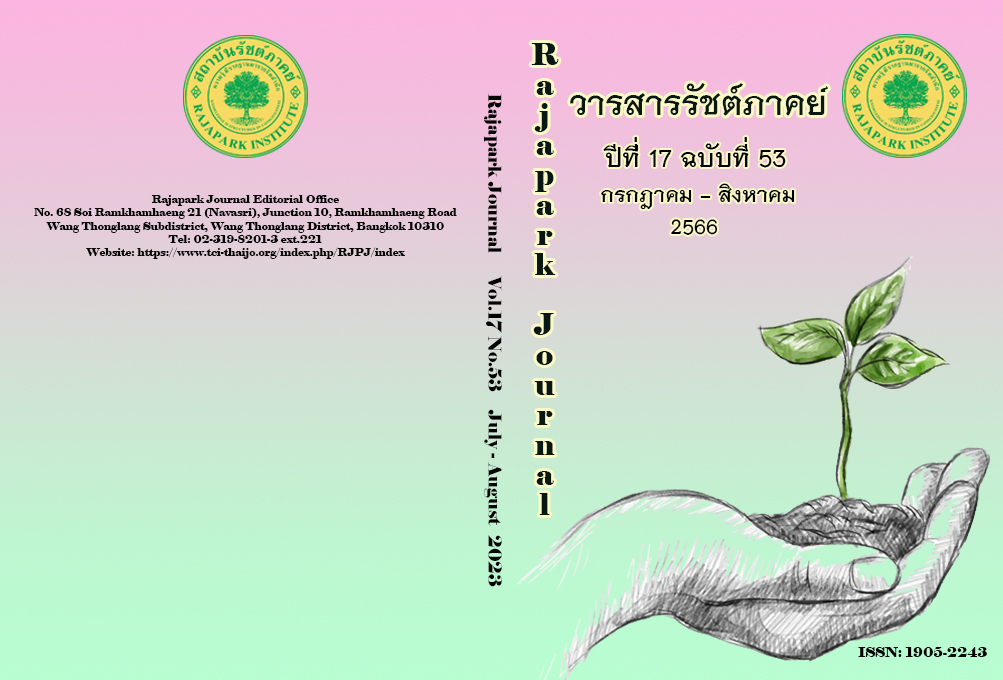Causal Factors Affecting of Social Capital and Performance of the Cooperative Movement in Thailand
Main Article Content
Abstract
Cooperatives are important to the Thai economy. The cooperative system has a population of more than 11 million people and an operating capital of more than 3.5 trillion baht. The cooperative system consists of specialized business units that rely on social capital to benefit business cooperation. This research aimed to study 1) Social Movement, Board’s role, and Worker Cooperative System factors that affect Social Capital and Performance; 2) The influence of variables on Social Movement, Board’s role, and Worker Cooperative on System Social Capital and Performance; and 3) a model creating for the Causal factors that influence cooperative movement’s social capital in Thailand. This research used quantitative and qualitative research methods. The data were collected through questionnaires. The population was from agricultural cooperatives in Thailand, with a total of 400 samples. The data were used for Structural Equation Modeling (SEM) analysis and sampling with a specific method for the six experts focus group to confirm the study results. The research results were as follows: 1) Social Movement, Board’s role, and Worker Cooperative System variables influence social capital and performance. 2) Social Capital variables were directly influenced by Social Movement, Board’s role and Worker Cooperative System. Performance variables were directly influenced by Social Movements, Board’s Role and Worker Cooperative System. Performance variables were also indirectly influenced by Social Movements, Board’s role and Worker Cooperative System. 3) The causal factors model that influence cooperative movement’s social capital in Thailand is new and cognitive. It is sorted from bottom up to top up as follows: Worker Cooperative System, Social Movement, Board’s Role, Social Capital and Performance.
Article Details

This work is licensed under a Creative Commons Attribution-NonCommercial-NoDerivatives 4.0 International License.
Views and opinions appearing in the Journal it is the responsibility of the author of the article, and does not constitute the view and responsibility of the editorial team.
References
Apostolakis, G., & Dijk, G. V. (2018). Cooperative Organizations and Members’ Role: A New Perspective. Working Paper CIRIEC No. 2018/04. Retrieved from https://www.ciriec.uliege.be/wp-content/uploads/2018/07/WP2018-04.pdf
Bertalanffy, L. V. (1968). General Systems Theory Foundation, Development, Applications. University of Canada.
Chang, S. C., Tu, C. J., Li, T-L., & Tsai, B-K. (2010). Social Capital, Cooperative Performance, and Future Cooperation Intention Among Recreational from Area Owners in Taiwan. Social Behavior and Personality, 38(10), 1409-1430.
Choi, E., Choi, W., Jang, S., & Park, S. (2014). Does the Effectiveness of Board of Directors Affect Firm Performance of Consumer Co-operatives? The Case of ICOOP Korea. Annals of Public and Cooperative Economics, 85(3), 371-386.
Couderc J.-P., & Marchini, A. (2011). Governance, Commercial Strategies and Performances of Wine Cooperatives: An Analysis of Italian and French Wine Producing Regions. International Journal of Wine Business Research, 23(3), 235-257.
Democracy at Work Institute. (2015). Worker Cooperative Definition. US Federation of Work Cooperatives, Adopted 2015.
Dickstein C. B. (1986). The Roles of Support Organizations in Worker Cooperative Systems: A Comparative Case Study[Doctoral Dissertation, University of Pennsylvania]. Retrieved from https://repository.upenn.edu/dissertations/AAI8614782
Dolp, F. (1964). Stabilizing Employment of Farm Labor Through Cooperative Organization: A Study of Sequoia Farm Labor Association, Tulare County, California. University of California.
Garrido, M. M. (2018). Worker Cooperatives and their Entrepreneurial Process. Theoretical Foundations and Empirical Evidence from the Worker Cooperatives Established in the Valencian Community, 2008-2014. Journal of Business, 10(1), 2-23. https://doi.org/https://doi.org/10.21678/jb.2018.876
Gray, T.W. (1986). Member Control Mechanisms from Western Europe. Journal of Agriculture Cooperation, 1, 56-74.
Green J. J. (2002). Community-based Cooperative and Networks: Participatory Social Movement Assessment of Four Organizations. University of Missouri-Columbia.
Hao, J. (2018). Cooperative Member Commitment, Trust and Social Pressure--the Role of Members’ Participation in the Decision-making. In The 30th International Conference of Agricultural Economists. July 28 - August 2, 2018, Vancouver.
Liang, Q., Huang, Z., Lu, H., & Wang, X. (2015). Social Capital, Member Participation, and Cooperative Performance: Evidence from China’s Zhejiang. International Food and Agribusiness Management Review, 18(1), 49-78.
Majee, W. (2007). Cooperatives and the Creation of Social Capital: The Case of Caring Home Services. University of Wisconsin-Madison. ProQuest Dissertations Publishing, 3294049.
Matthews, W. A. (2007). The Residual Control Roles of Cooperative Boards of Directors: A Preliminary Comparative Analysis. University of Missouri Columbia, ProQuest Dissertations Publishing, 3349043.
Nuno, D. G. (2008) The Social Capital Effect in Nonprofit Human Service Organizations: An Examination of Potential Outcomes of Organizational Social Capital Relates to Effectiveness[Doctoral Dissertation, The University of Texas at Arlington].
Pönkä, V. (2018). The Legal Nature of Cooperative Membership. Journal of Entrepreneurial and Organizational Diversity, 7(2), 39-61.
Richards, A., & Reed, J. (2015) Social Capital’s Role in the Development of Volunteer-led Cooperatives. Social Enterprise Journal, 11(1), 4-23. DOI:10.1108/SEJ-09-2013-0037
Sdrali, D., Rizou, M-G., Giannouli, P., & Makris, K. (2016). What Motivates Employees to Engage in the Social Economy Sector? A Case Study of Greek Cooperative Enterprises. International Journal of Social Economics, 43(12), 1334-1350. DOI:10.1108/IJSE-10-2014-0212
Stoll, J. A. (2012). The Internet and Social Capital Among Co-operatives in Canada. University at Buffalo, State University of New York. ProQuest Dissertations Publishing, 3541303.
Wadsworth, J.J. (2000, Oct.). Assessing Performance and Needs of Cooperative Boards of Directors. Cooperative Information Report (CIR) 58, United States Department of Agriculture. Retrieved from https://www.rd.usda.gov/sites/default/files/cir58.pdf
Wilson, A. (2010). Co-opting Precariousness: Can Worker Cooperatives be Alternatives to Precarious Employment for Marginalized Populations? A Case Study of Immigrant and Refugee Worker Cooperatives in Canada. Just Labour: A Canadian Journal of Work and Society, 16, 59-75. Retrieved from http://www.justlabour.yorku.ca/volume16/pdfs/06_wilson_press.pdf
Xu, Y., Liang, Q., & Huang, Z. (2018). Benefits and Pitfalls of Social Capital for Farmer Cooperatives: Evidence from China. International Food and Agribusiness Management Association, 21(8), 1-16. DOI:10.22434/IFAMR2018.0024
Yamane, T. (1967). Statistics: An Introductory Analysis (2nd ed.). Harper and Row.
Yu, L., & Nilsson, J. (2019), Social Capital and Financial Capital in Chinese Cooperatives. Sustainability, 11(8), 2415. DOI:10.3390/su11082415


